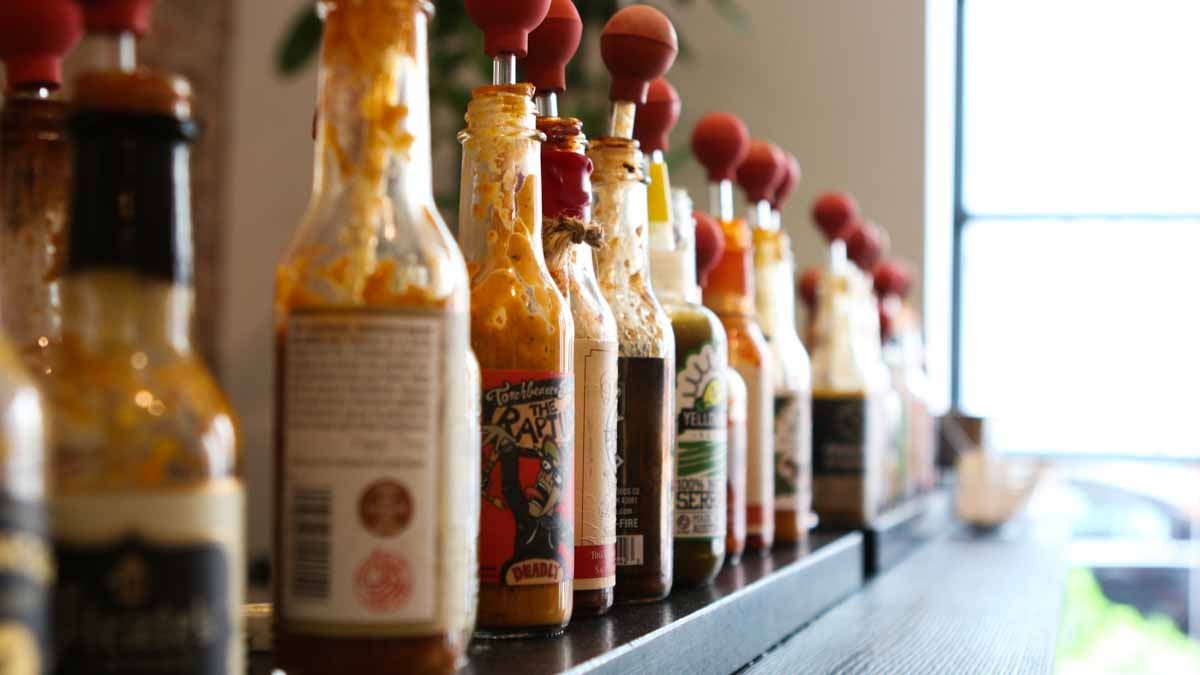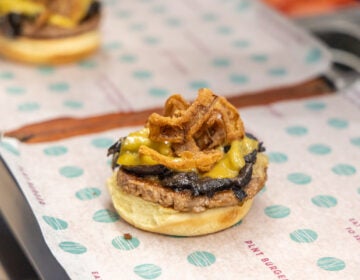What’s really behind our love of spicy food?
Listen 7:06
The concoctions inside these bottles are too potent to be gulped from a glass. (Joel Wolfram/for The Pulse)
At a stylish shop in Brooklyn, a different kind of ‘sommelier’ guides tastings from a row of small bottles lined up on the counter. He uses a dropper to squeeze tiny portions of the bottles’ technicolor contents onto strips of paperboard held by a steady procession of customers that flows through the shop. The concoctions inside these bottles are too potent to be gulped from a glass.
After trying a few samples, customer Jimmy Nelson looks flushed.
“I guess that ghost pepper one got me,” he says between sniffles.
Heatonist is the name of the shop, and it sells just one product: hot sauce. It keeps about a hundred different bottles in stock, a selection narrowed down from thousands tasted by founder Noah Chaimberg and his staff. These include a hot honey infused with scorpion peppers, a sauce featuring scotch bonnets, dark rum, and mustard in the style of the Caribbean Island of Barbados, and perhaps the fiercest of them all, a puree of pure ghost pepper.
Heatonist is a living monument to the pleasure that some of us get out of scorching our mouths with spicy food. With all the enthusiasm for hot sauce here, it’s easy to forget that nature has designed these foods to elicit pain, not pleasure.
“This is part of our chemical somatosensory system,” says Pamela Dalton, a senior scientist at the Monell Chemical Senses Center in Philadelphia, a research institute devoted to the study of taste and smell. “It’s part of the pain system.”
Dalton explains that chili peppers have a way of tricking our senses into sending a signal to the brain that we’ve touched something painfully hot. The main chemical responsible for this effect is called capsaicin, which activates the “vanilloid receptor 1.” This nerve receptor detects noxious heat, and when it’s triggered by capsaicin, we feel a burn just like the one we would get from sipping a cup of scalding hot coffee. When we take a bite of food seasoned with hot peppers, our mouths start producing excess saliva. Our noses and eyes begin to run, too, because they’re part of the trigeminal nerve system that’s stimulated when capsaicin touches our mouths.
“What the body’s trying to do is, it’s feeling that there’s an insult and it’s trying to dilute or wash out the invader,” Dalton says.
A case of ‘benign masochism’?
Though the body reacts to capsaicin as a threat, spicy foods aren’t actually harmful to us. Still, explaining why we enjoy the painful reaction is a puzzle that’s challenged scientists for decades.
Paul Rozin began studying this question in a village near Oaxaca, Mexico, in the 1970s as a psychology professor at the University of Pennsylvania. He noticed that the dogs and pigs roaming around the village ate the same chili-spiced food that the people ate, as they subsisted on leftover food scraps. However, the animals weren’t eating this food because they liked it. When given a choice between food with and without chili pepper, Rozin found that they always ate the plain food first.
He took this as an indication that there was something uniquely human that allows us to enjoy the burn of chili peppers. Indeed, further studies in the laboratory have confirmed that animals tend to avoid spicy food when given a choice (birds are an exception, but it’s believed they can’t sense the spice). This can’t be chalked up to mere desensitization from repeated exposure. Rozin found that, far from becoming numb to the sting of the peppers, chili eaters actually come to enjoy the painful sensation. And he realized that this wasn’t the only feeling of distress that some people enjoy.
“The best example is a roller coaster,” Rozin says. “Your brain and your body think that you’re plunging to death.”
Our bodies are telling us we’re in danger when we ride a roller coaster, but we know that we’re actually pretty safe. Rozin noted that such intense, negative sensations become pleasurable for some people when they occur in the absence of real danger. Their minds are able to override the body’s signals of danger and distress.
“There’s a certain pleasure in mind over body,” Rozin says.
Perhaps liking the burn of spicy food was another example of this human phenomenon, which he calls “benign masochism.”
Rozin thinks that the pleasure of eating spicy food can’t be entirely explained by something like an endorphin high that might follow the pain. For one thing, no one has been able to measure endorphin levels well enough to determine whether they’re a significant factor. Plus, Rozin says, if we ate spicy foods just for the endorphins, we would see animals get hooked the same way people do.
Sensation-seekers and show-offs
Rozin’s concept of benign masochism provided a framework for research seeking to identify personality factors that might be related to a taste for spicy food. Today, over 30 years later, food science professor John Hayes at Penn State University carries on this thread of investigation. He and his colleague, Nadia Byrnes, published a study in April this year where they found a correlation between liking spicy foods and a trait known as “sensation seeking.” In a nutshell, the trait describes a tendency toward thrill seeking but also includes a taste for other new or intense experiences. A questionnaire measuring sensation seeking, Hayes explains, will ask how much you agree with statements like, “I like movies with loud explosions, or “I like to travel to foreign countries and meet new people.”
The correlation with sensation seeking was not a big surprise. Another study Hayes and Byrnes published a few years ago also found a significant link. In the new study, however, they found an interesting relationship with another trait called “sensitivity to reward.” This trait was linked with eating a greater amount of spicy foods, but showed no correlation with actually liking a chili-laden meal. Hayes explains that sensitivity to reward factors in how we respond to social rewards like elevated status and approval. The findings, Hayes says, suggest that some people might be eating spicy foods not for the flavor, but out of a desire to show off or prove that they’re the kind of person who can handle the pain.
Hayes admits that he can only speculate about these motives based on the results of the recent study alone. But his interpretation resonates with the stories of some of the customers at Heatonist.
Customer Sarith Demuni says that, in his Sri Lankan family, “if you don’t like spicy food, you’re just made fun of all the time.”
But for Heatonist founder Chaimberg, enjoying hot sauce is all about the flavor.
“It’s food that goes on food,” he says. “So for us, we’re always thinking about what are the flavors here, what are people going to enjoy it with.”
While it could be that some people seek out the spiciest peppers and sauces they can find just to prove their toughness, that’s not the crowd Chaimberg is catering to. After all, you don’t need a sommelier for that.
WHYY is your source for fact-based, in-depth journalism and information. As a nonprofit organization, we rely on financial support from readers like you. Please give today.







